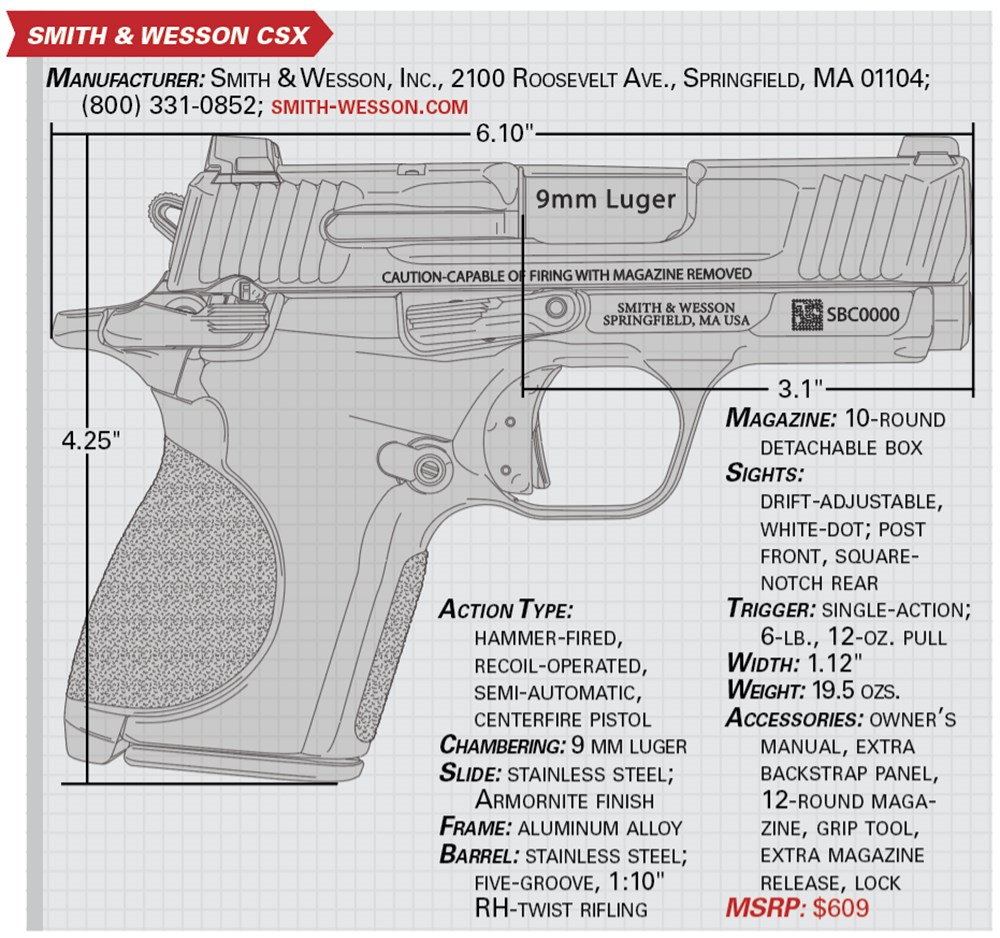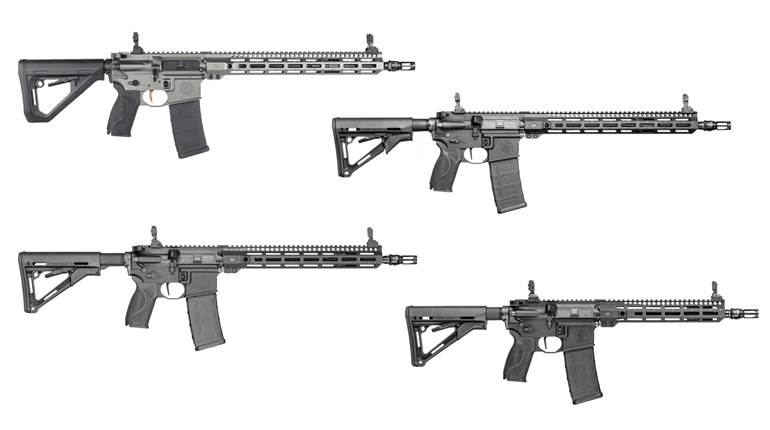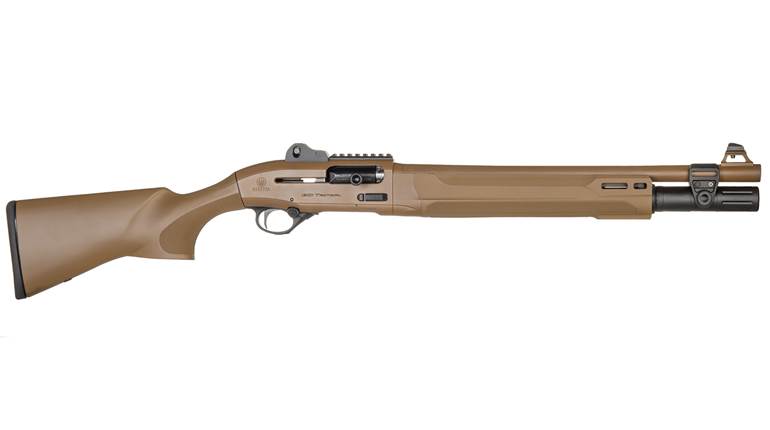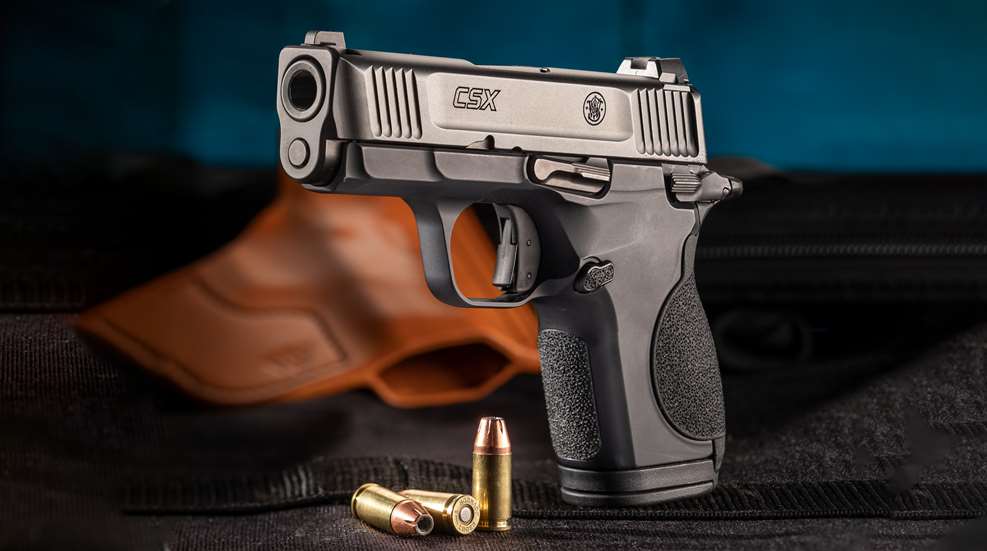
Smith & Wesson’s new CSX, shown with Hornady 115-grain XTP cartridges and a Wright Leather Works Bandicoot pocket holster, brings a metal frame and hammer-fired action to the 10-round micro-compact 9 mm category.
The micro-compact concealed-carry market has exploded during the past decade. First, locked-breech 9 mm Luger handguns were shrunk to a size once reserved for .32 and .380 ACP “mouse” guns. Then, engineers found a way to pack 10 rounds into that tiny space.
Smith & Wesson has followed this trend, first with its single-stack M&P Shield (more than 3 million of which have been sold to date) and then with the recent addition of the 13-round Shield Plus. Despite the popularity of these two models, the company was not content with its micro-compact lineup. To that end, in January of this year, S&W brought out something decidedly different in the micro-compact market: the all-new CSX.
On paper, the CSX checks all the boxes that other pistols in this category conform to—overall length of about 6", height of about 4.5", width around 1" and weight right at 20 ozs. with a magazine that fits flush and holds 10 rounds. And that’s where the similarities end. All of the other pistols in this category, including Smith & Wesson’s own Shield Plus, have two glaring differences from the CSX—they’re striker-fired and they use a polymer frame.
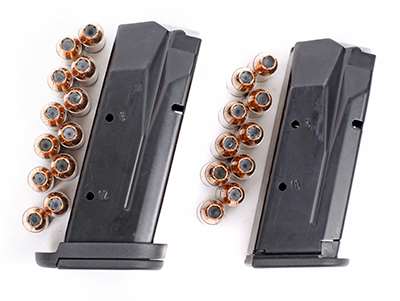
The CSX features a metal frame machined from aluminum alloy, and its rounds are set off by an external hammer striking a firing pin. The trigger and hammer function in single-action mode only, with a manually applied thumb safety that allows the pistol to be carried “cocked-and-locked” with a round in the chamber. As its metal frame and external hammer should tell you, the CSX is a bit of the curmudgeon’s choice in the micro-compact category these days. Accessory rail? Optics cut? Get out of here. In these ways, the CSX is similar to other “9 mm Mustang-type” pistols on the market, such as the SIG P938 and Kimber Micro 9, but it nearly doubles their capacities in a package that is roughly the same size.
“Since the launch of the M&P Shield pistol, Smith & Wesson has been invested in the compact concealed-carry firearm market. With the design of the CSX, we started with a fresh canvas, providing the consumer with a completely different option for concealed carry,” said John Myles, S&W’s senior product manager, in a press release announcing the new pistol’s launch.
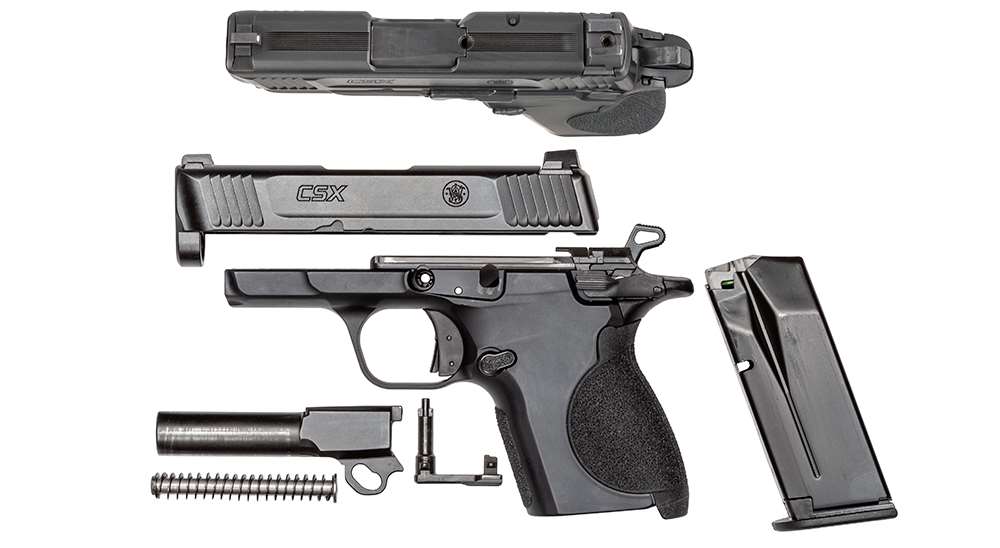
The “CS” in the name is an obvious play on Smith & Wesson’s Chief’s Special line of handguns. It all started in 1950 when S&W introduced its first J-frame revolver, the Model 36, which got the moniker “Chief’s Special.” The Chief’s Special quickly became the go-to backup and deep-concealment revolver for law enforcement. Smith & Wesson would later apply the “CS” designation to compact versions of the company’s Third Generation DA/SA semi-automatic handguns, making single-stack semi-automatic Chief’s Specials in 9 mm, .40 S&W and .45 ACP. Though short-lived, these small semi-automatics have developed a cult following among S&W enthusiasts.
And the “X?” I like to think it stands for “eXtreme.” While duplicating the overall size and weight of the original Chief’s Special, the CSX doubles a .38 Spl. J-frame’s capacity and also doubles the capacity of a six-shot service revolver with its extended 12-round magazine. Basically, Smith & Wesson has crammed as many rounds of serious self-defense ammunition as possible into a package the size of its original modern deep-carry firearm.
At first glance, the CSX combines the external features of both the company’s M&P striker-fired pistols and M1911s. Its 18-degree grip angle is familiar to M1911 and M&P shooters. In an effort to minimize the grip’s circumference, the CSX doesn’t have traditional stock panels. The bare aluminum frame acts as part of the grip, and the CSX comes supplied with two polymer backstrap panels. On the small “palmswell” version of the panel, the texturing extends to the sides of the frame. The “extra small” panel only covers the rear portion of the frame. A supplied polymer tool depresses a plunger that holds the backstrap panels in place so that they can be changed. The front of the frame grip has a textured polymer panel inserted. All polymer grip surfaces have a “sandpaper” texture familiar to those who have handled a Shield. The CSX’s 10-round magazine will leave the pinky looking for a home for those with average-sized hands. The extended, 12-round magazine adds about a quarter inch to the grip length and will afford most shooters a full-handed hold.
The CSX’s stainless-steel slide and barrel are finished in Smith & Wesson’s Armornite hardened-nitride finish, and the alloy frame is anodized matte black. The external contours of the CSX are optimized for concealed carry, with all edges, even the rear corner of the ejection port, rounded and contoured for snag-free use. Both the front and rear of the slide feature aggressive serrations. At the rear, “EZ-tab” extensions provide a positive purchase when gripping the limited surface area of a micro-compact pistol’s slide.
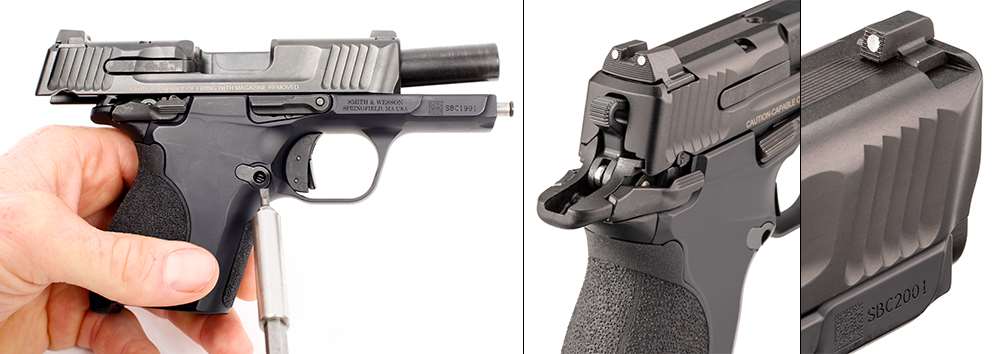
The CSX is a recoil-operated, locked-breech pistol. The barrel uses a square hood that locks into the slide in the fashion of nearly all modern semi-automatic pistols. A cam machined into the barrel lowers it to unlock the action as the slide moves to the rear. A “witness hole” in the barrel hood serves as a loaded-chamber indicator.
The pistol is equipped with bilateral thumb safeties in the traditional M1911 position. Though the size of the safety lever is minimal, it is easy to manipulate with the thumb of the shooting hand. Unlike a traditional M1911, the slide can be retracted, and the hammer cocked, on the CSX with the safety engaged. The slide release is also bilateral. Smith & Wesson supplies two magazine releases with the CSX so that the user can choose between a right- or left-side release. They can be quickly swapped with the use of a small screwdriver. The ovular shape of the release button is easy to reach for most hands and features the texture of the grip panels.
Though single-action with a manual safety, the CSX has an additional trigger-shoe safety more commonly associated with striker-fired handguns. Don’t expect the CSX to have an M1911 trigger. The pivoting trigger has a slight takeup before breaking; the trigger is also heavy for a single-action, manual-safety system. My test pistol’s trigger was just over 7 lbs. out of the box and broke in to about 6 lbs., 12 ozs.—more than a pound heavier than the Shield Plus I recently shot. Don’t expect a nice M1911 reset either; if you try to release the CSX’s trigger to what you expect would be the reset point, you’ll get a light click that will fool you into thinking you’ve reached the reset point. The trigger needs to go nearly all the way out to fully reset.
Though the heavy trigger pull seemed as if it would be an impediment to accuracy, the CSX averaged five-shot groupings of slightly more than 1" at 7 yards. The pistol is equipped with metal sights fitted into front and rear dovetails on the slide. The front dovetail is the same as the M&P, but the rear is unique. The sights feature three white dots and are serrated on their face to reduce glare. The top of the slide has glare-reducing straight serrations.
One of the first things you’ll notice when firing the CSX is its extremely low bore axis, especially for a hammer-fired pistol. Comparatively speaking, it’s in the neighborhood of what you’d expect for a striker-fired handgun. The CSX is +P-rated and even when firing these extra-pressure rounds, recoil was controllable and bearable through an extended range session. The extended beavertail of the frame design allows for a high grip without any problems with hammer bite. If you ride the safety, as some M1911 shooters do, you might get the slide to crease the web of the hand. It never drew blood, and adjusting the grip so that the thumb is below the safety never accidentally engaged it.
The true engineering miracle of modern micro-compact handguns like the CSX is their omnivorous appetite. High-performance cartridges in small semi-automatic handguns used to be a recipe for a finicky eater, but the CSX consumed everything we fed it—from target velocity to +P, screwdriver-tipped Preferred Defense 65-grain Interceptor bullets to flat-nose target FMJs, without a hitch. Even when the slide dragging on the web of my hand noticeably slowed the action cycling, the CSX functioned perfectly. I just couldn’t make it malfunction. Accuracy across this wide variety of ammunition was also surprisingly consistent.
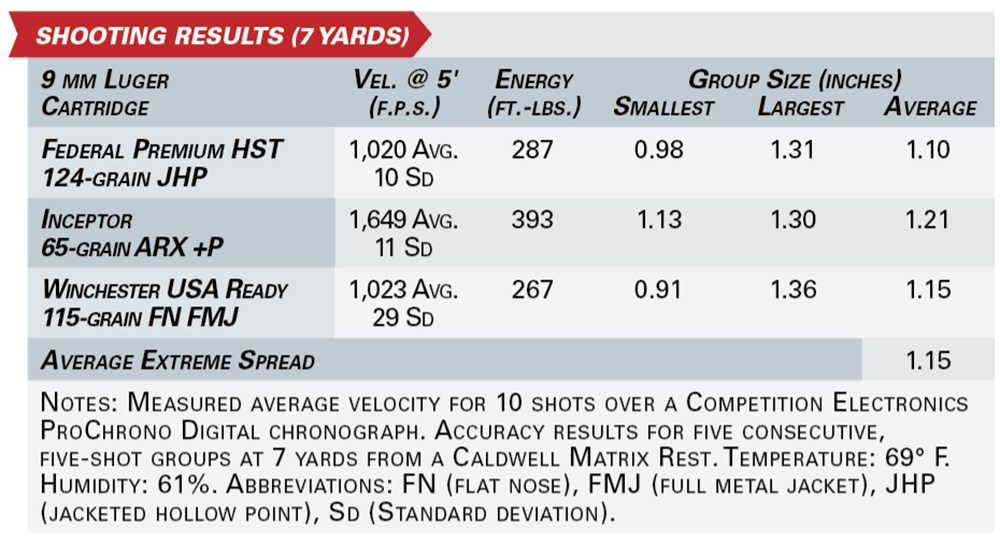
The extended magazine features a slide-on grip extension that gave me some trouble in testing. As the piece extends to the rear of the grip, it had a tendency to catch on the palm of the hand and prevent an empty magazine from ejecting fully. A conscious effort to remember to relax the firing grip was necessary to get the 12-rounder to drop free. My preferred carry method was to use the 10-round magazine, sacrificing capacity and grip area in exchange for a quick and reliable magazine change, with the 12-round magazine carried as backup. Both magazines were difficult to load to their full capacity when new and were hard to seat when fully loaded with the slide forward, but eventually broke in. The other magazine issue that did not break-in is that loaded magazines swell and will not drop free, even when they’re down a few rounds from full capacity. In a “tactical reload” situation, you may be forced to rip a partially-loaded magazine from the CSX before the next mag can be loaded.
Disassembly of the CSX requires a small punch. The axle of the left-side slide release is lined up with a takedown notch in the slide and pushed through. This allows the slide assembly to be removed from the frame and the barrel and mainspring to then be removed from the slide to complete fieldstripping. To re-assemble, put the slide assembly back on the frame, line up the notch and press the slide release back into place.
For the shooter who wants a high-capacity, micro-compact 9 mm Luger handgun with a metal frame and an external hammer, the CSX is virtually the only choice. Even if you’re not a traditionalist, the CSX holds its own with the striker-fired, polymer frame models in this highly competitive category. In fact, it may be a trigger job and re-designed magazine away from being best-in-class. 